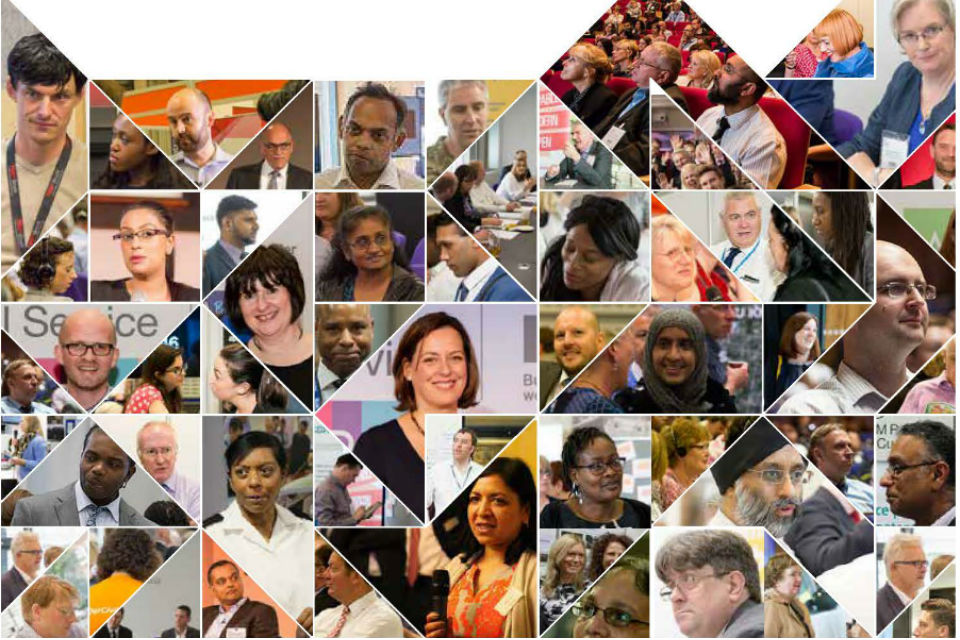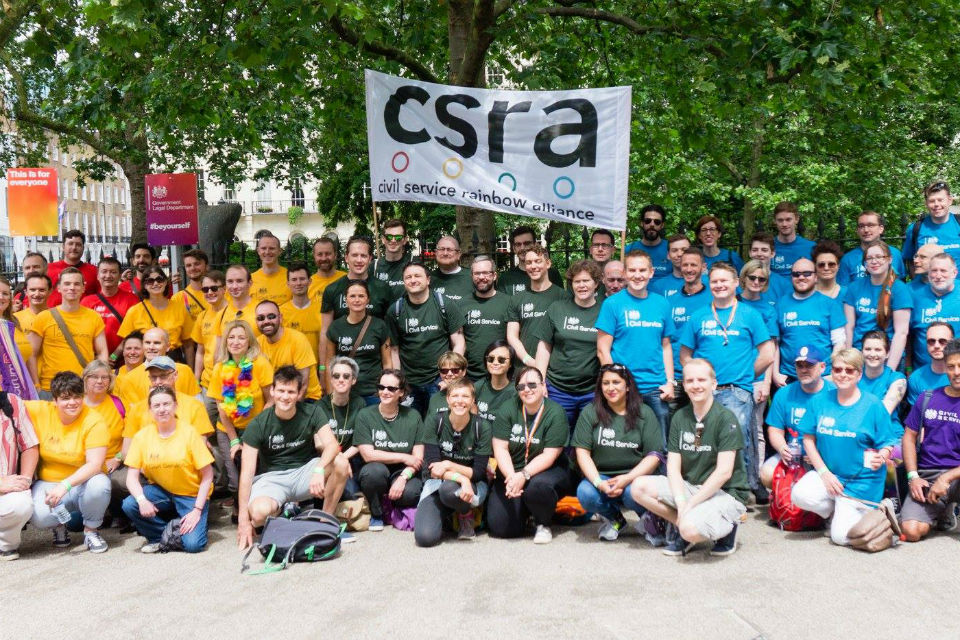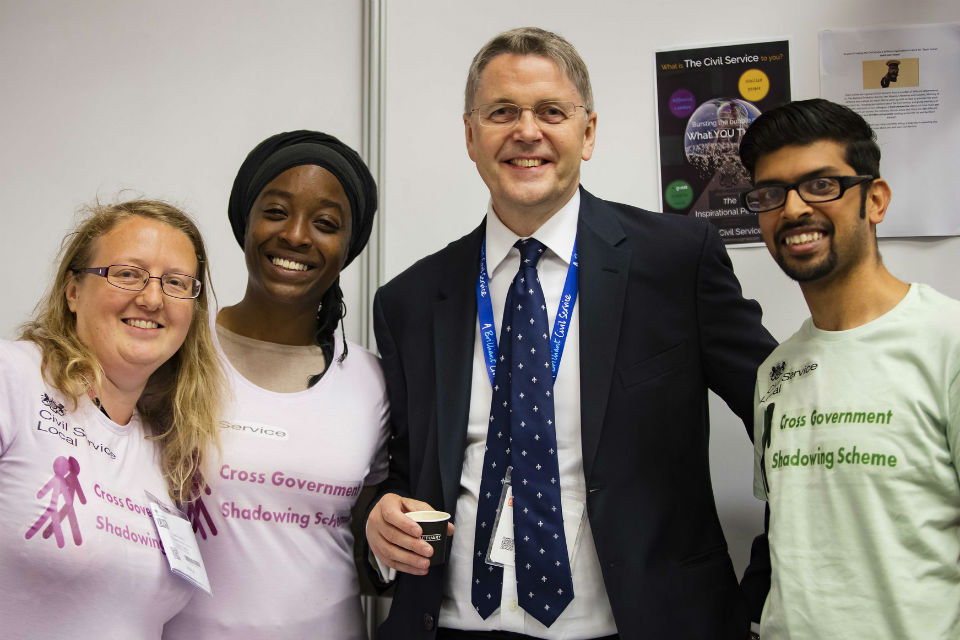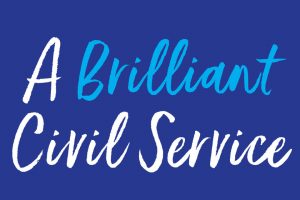
Welcome to this special edition of CSQ. I am delighted to contribute because delivery of real and measurable improvement in diversity and inclusion (D&I) is one of my top priorities as Head of the Civil Service.
As an organisation we have the – unashamedly – ambitious aim of making the Civil Service the UK’s most inclusive employer by 2020. Elsewhere in this edition you will find detailed accounts of some of the practical steps the Civil Service is taking – and some of the challenges we face – in realising this ambition, including our new Civil Service Diversity and Inclusion Strategy. I want to take this opportunity to examine why diverse and inclusive workplaces are so important – particularly for the Civil Service.
A faithful reflection
We need to be more comfortable talking about diversity and inclusion and recognise that greater diversity benefits us all.
First, there is an existential reason why we civil servants should be a diverse group. A national institution like the Civil Service, which aspires to serve the whole country, must look like the country it serves. Society – and all the diverse groups it comprises – should see in its public servants a faithful reflection of itself, in all its diversity. We should always be looking to hire and to give opportunities to the best, most hard-working, most dedicated people we can attract, irrespective of background, and to ensure all feel accepted and valued in their workplace. There is a moral imperative here.

Second, it’s clear that diversity by itself is not enough. It’s not just that we need to recruit more people from underrepresented groups. We also have to ensure that everyone who works in the Civil Service feels supported, valued and respected and able to contribute to their best. In her article, Jazz Bhogal, quotes an American diversity advocate: “Diversity is being invited to the party; inclusion is being asked to dance.”
There is plenty of evidence that diverse and inclusive organisations perform better and have happier people. As an example, such organisations deliver better outcomes in customer-facing roles, in Jobcentres and on our borders, where they are serving people from a wide variety of different backgrounds. Joanna Parry’s work (as an Entry Clearance Officer in Pretoria, South Africa) on the RESPECT programme for increasing understanding of different ethnicities, as well as collaborating to achieve a common goal, won her the 2016 Civil Service Championing Inclusion Award. RESPECT has already been rolled out across the UK visa network in Africa.
Diversity and inclusion is not just about external factors, but about differences in thought and outlook. We artificially narrow our vision and our understanding of the world if we surround ourselves only with people who look and think like us. This will tend to produce ‘Groupthink’: conclusions that reflect a shared, closed outlook. The evidence shows that diversity – of background, of life experience – creates challenge, provokes thought and encourages change and innovation if it is free to flourish in an inclusive environment. This is because it allows different insights – especially valuable in tackling the sort of complex, ambiguous problems that government faces every day. And it produces better advice to ministers and better decisions – better because they are more attuned to the needs and interests of all groups.
Quite simply, we are cutting ourselves off from a rich source of talented people if we don’t appeal to, attract, retain and engage staff from all corners of society. I want the Civil Service to be a true engine of social mobility in Britain. We are addressing this in a variety of ways, including through a more flexible employment offer, implementing shared parental leave for all civil servants, the introduction of the award-winning Civil Service Job Share Finder, and through outreach initiatives. These include our support for the Inspiring the Future scheme, under which civil servants go out to schools as advocates of a civil service career in one of the unrivalled range of roles it offers.
Inclusion is essential
It’s now almost commonplace in the debate around equality to observe that an organisation can be diverse without being inclusive; or inclusive without being diverse. For all the research that shows diversity making a positive difference to a team's performance, other findings show that it makes no difference, and other evidence again that it can actually be detrimental, when it is not coupled with inclusion or an inclusive culture.
A government that works for everyone, should be a government (and a Civil Service) where anyone, whatever their background, can expect to feel valued and respected, and go as far as their ability will take them. This means from top to bottom of the organisation.
The Civil Service today is more diverse than at any time in its history. The proportions of civil servants who declare a disability (9.9%) and those who are from ethnic minorities (11.6%) are at record highs; and women make up over 40% of senior civil servants, better than many (if not most) large private sector organisations in this country. However, representation of society’s diverse groups is much less evident at the higher grades and varies across different departments, agencies and professions. Of the 34 permanent secretaries, 10 are women – not nearly enough – and none is currently from an ethnic minority.
There is much to do on the inclusion front. Our comprehensive annual staff engagement surveys tell us that our employees can have very different lived experiences in their work environments. For example, civil servants with a disability are less likely to say they are treated fairly at work, compared to those without a disability; and those who are both ethnic minority and LGBO (lesbian, gay, bisexual or other)* say they have experienced a higher level of discrimination in the last year compared to heterosexual staff. These are unacceptable differences and highlight that increasing diversity needs to be coupled with an inclusive environment where everyone is treated fairly and with respect.

Dismantling barriers
Inclusion is about ensuring all people feel they belong. It is about giving space to and valuing all the different kinds of life experience and opinions I spoke of before. For example, this means ensuring that there is not a dominant ‘macho’ or ‘posh’ culture of senior leaders in the organisation that makes female or ethnic minority staff, or those from working-class backgrounds, feel ill at ease or out of place.
But dismantling long-established behavioural or cultural ‘norms’ and other institutional barriers that allow pernicious attitudes to persist, will take much more than just driving up our diversity numbers. It is a long-term goal to recognise and remove bias and discrimination from our systems and procedures. This work – encouraging a culture that is oblivious to everything but the quality of the individual, and giving everyone an equal chance of succeeding – began in earnest with our 2014 Talent Action Plan. We are introducing better recruitment and promotion practices, with initiatives including unconscious bias training, a name-blind approach to selection, and making all-male and all-white recruitment panels the exception. In addition, we are setting clear, inclusive career paths to senior management levels through programmes including the Fast Stream, the Future Leaders and Senior Leaders schemes, and the Positive Action Pathway.

To instil more inclusive behaviours towards colleagues with a disability, and help recruit, retain and develop disabled people, the Civil Service has committed all departments to the Government’s Disability Confident scheme. This gives employers the tools to be more confident in employing, retaining and developing disabled people, and actively to identify and remove barriers to their realising their potential. Additionally, mechanisms like the Workplace Adjustment Passport are available, making it easier for colleagues to move between roles and providing for needs such as adapted technology to allow them to perform at their best.
Social mobility
Our diversity drive to date has focused mainly on gender, race, sexual orientation and disability. But we also want to harness the talents of people who opt for non-academic routes to employment, or who tend to be excluded or deterred by existing recruitment practices. We are implementing recommendations from the independent Bridge Group report, which set out in detail how we could increase social mobility in the Civil Service’s flagship graduate scheme, the Fast Stream. This includes expanding our outreach activities, offering better incentives for interns to apply, shortening the length of the assessment process to under 12 weeks, and opening regional assessment centres.
These measures are already having an effect. The record 45,000 applicants for the 2017 Fast Stream were more strongly representative of the UK population than any previous group.
Civil Service Apprenticeships are a credible alternative to university. We have pledged to deliver at least 30,000 apprenticeship starts by 2020 in England. The expanding Fast Track scheme for school-leavers now offers 750 places. I want apprentices to be seen as equal in value to graduates, with the same opportunities to progress to senior roles in the Civil Service. The creation of apprenticeships in areas such as digital and cyber will also help us meet critical skills needs in a rapidly changing world.
To deliver our vision of inclusivity we must use all the modern tools at our disposal, including data analysis. We must be open to learning from what other organisations are doing, as well as developing our own innovative approaches. We will action what the People Survey and other research tells us about attitudes towards D&I in the Civil Service and the factors that contribute to lack of diversity and inclusion.
An evidence-based approach
One area of innovative progress is the work on increasing socio-economic diversity in the Civil Service, assisted by a research initiative in collaboration with employers and more than 30 organisations involved with social mobility. This is designed to establish a set of measures that will help us better understand the socio-economic backgrounds of workforces and applicant groups and tailor our recruitment processes accordingly.
Similarly, our adoption of ‘name-blind’ recruitment was led by the growing evidence that it really works. Studies have consistently shown that perceptions of job applicants are skewed when recruitment panellists know their names and backgrounds, even though this information is, and should be, irrelevant to the employer.
One of a range of new tools that allow a more evidence-based assessment of applicants is ‘Applied', designed by the Behavioural Insights Team in partnership with the Cabinet Office and innovation charity Nesta. As well as the Civil Service, 29 other organisations are now using this platform to help remove implicit bias from recruitment decisions.
Wider initiatives such as the Race Disparity Audit (considered in detail elsewhere in this edition), designed to inform improvements in the services we provide for all ethnic groups, may also inform greater equality of opportunity within the Civil Service. The audit will collect and publish in one place the Government’s data about differences in treatment or outcome affecting people of different ethnicities.
We are also working with others to establish a new framework for the measurement of inclusion. The idea is to establish quality standards for inclusive leadership, which will be used in our new Leadership Academy, as well as in our selection process, career pathways and performance management systems.
When we are designing and developing new policy or deciding on new ways of delivering services, we should first ask whether we have the people with the insight to make the most effective decisions. Policy-making with implications for people with a disability would benefit from the insight of someone in the team with a disability; and officials addressing the issue of radicalisation should include someone who understands the communities and individuals most vulnerable to it. This looks like common sense; but like most things we describe in this way, it is not nearly as common as it ought to be.
A role for everyone
Over and above this, there’s a role for every one of us in creating an inclusive culture in the Civil Service and making it a truly great place to work. That’s why I made sure that diversity and inclusivity targets are part of my own objectives and those of all Permanent Secretaries to ensure greater leadership and accountability here. The value of mentoring by senior civil servants, sharing knowledge and advising colleagues from underrepresented groups on advancing their careers, should also be recognised and valued as mutually beneficial. Certainly, I have found my own experience of mentoring young, enthusiastic ethnic minority staff to be both personally fulfilling and also enlightening. It gives me a different and invaluable take on the organisation I lead.
It is the dedication of brilliant individuals – as well as the collective commitment from the top – that is driving inclusion in the Civil Service. Individuals like Mushtaq Raj, who won the Civil Service Diversity & Inclusion Award for Championing Minority Ethnic People. He has been described as the ultimate role model for ethnic minority causes for his leadership of THE NETWORK, the Home Office's BAME staff network, with around 3,000 members.
An inclusive workforce is one where people, whatever level they work at, feel free to be themselves and that they do not have to change to ‘fit the system’. They can express their opinions without fear of recrimination, because they are treated with respect. It shouldn’t then surprise us that they are also more motivated, innovative, productive and often healthier, both physically and psychologically.
On her return to No. 10 after the June 2017 General Election, the Prime Minister rededicated her government to: “put fairness and opportunity at the heart of everything we do, so that we fulfil the promise of Brexit together and – over the next 5 years – build a country in which no one and no community is left behind. A country in which prosperity and opportunity are shared right across this United Kingdom.”
 To support the Government in this, the Civil Service must itself be representative of the whole country. There is still some way to go, but everything you read in this edition of Civil Service Quarterly underlines our commitment to achieving that goal.
To support the Government in this, the Civil Service must itself be representative of the whole country. There is still some way to go, but everything you read in this edition of Civil Service Quarterly underlines our commitment to achieving that goal.
We should all be asking ourselves what we can do to make this happen, so that all of us in our brilliant Civil Service can talk about – and benefit from – diversity and inclusion.
* The Office for National Statistics reports Civil Servants' sexual orientations as Heterosexual / Straight, Gay / Lesbian, Bisexual or Other. The term LGBO is used to refer to staff who report belonging to one of the last three groups.
Recent Comments